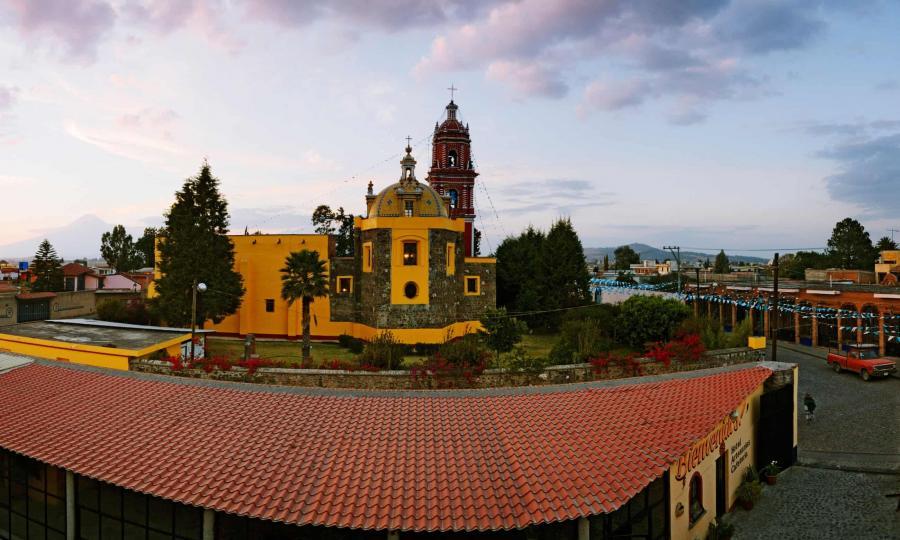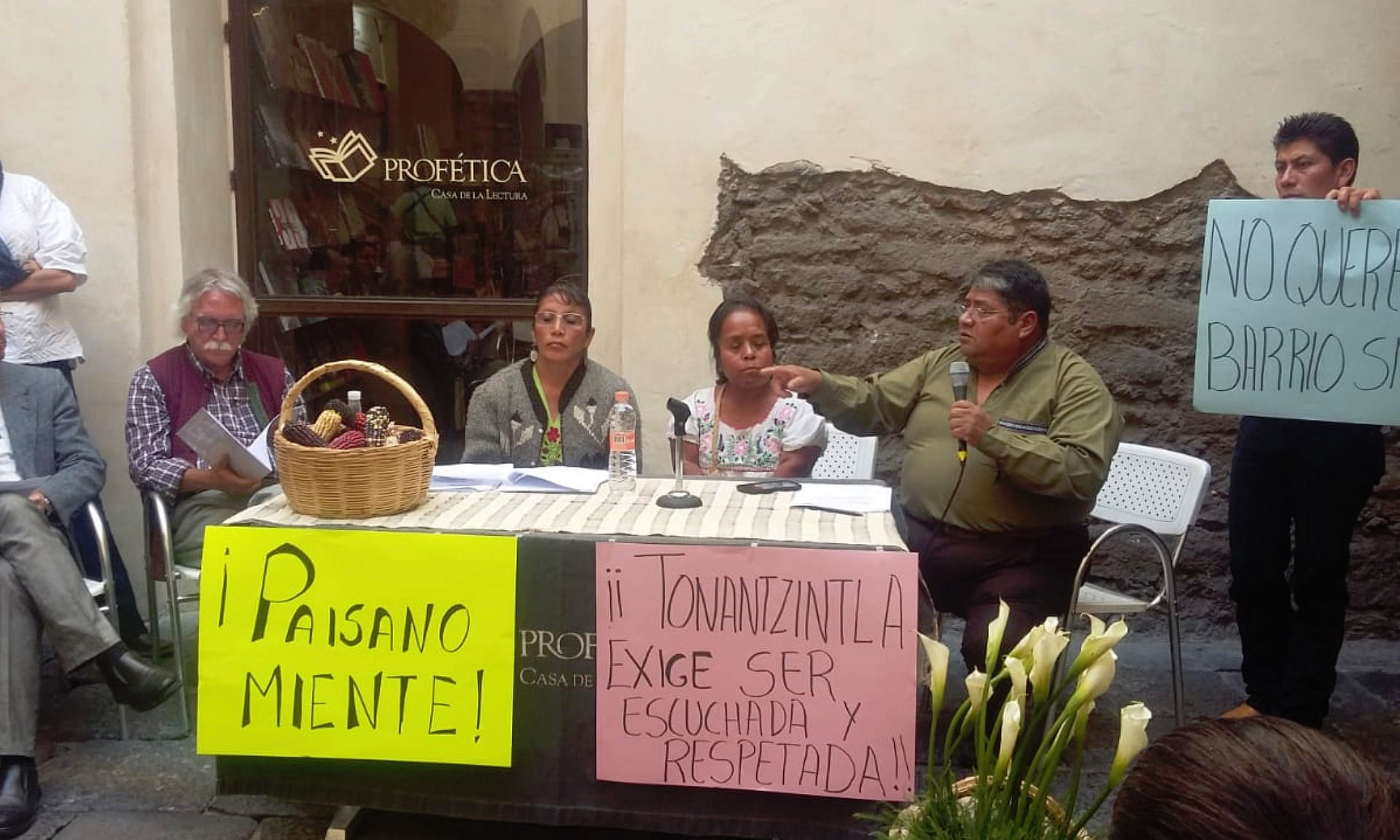
Santa Maria Tonantzintla was set to be one of Mexico’s first smart cities – but residents saw it as an attempt to westernise their town and leave tradition behind
Lupita Tecual Porquillo had heard a rumour that the plaza was going to be “remodelled.” The 51-year-old grocery store owner lives around the corner from the centre of Santa Maria Tonantzintla, a sleepy town in the state of Puebla, about three hours from Mexico City. She assumed “remodelling” meant repairing the plaza’s centuries-old cobblestone pavement.
In November 2017, heavy machinery arrived to tear out the characteristic cobblestones and replace them with smooth, uniform stone tiles. On 11 January, Tecual Porquillo discovered the municipality had also knocked down the clock tower and stucco bridge – both beloved landmarks in the central plaza.
Rumours spread among the residents of Tonantzintla. They heard that a gourmet market would open along the plaza, that ticket booths would appear outside the church to charge for entry, that a building would be demolished to make room for a parking lot for tourists. Some even said that religious processions – a crucial part of civic life – would no longer pass through the plaza.
A meeting for affected residents later revealed that Tonantzintla was to become part of a pilot project: smart cities.
Smart cities integrate technology into urban infrastructure, usually to improve sustainability, maximise efficiency and minimise energy usage. It’s a strategy generally undertaken in major metropolitan areas – like Singapore, Barcelona and Seoul – with specific technologies and strategies varying from place to place. In London, for instance, it involves the use of sensor networks to monitor traffic flow and allows citizens to report graffiti using an app.
Last year Puebla’s governor José Antonio Gali Fayad announced a statewide Barrio Smart (smart city) initiative in conjunction with the organisation Alianza Smart Latam. According to the initiative’s website, the project has “the objective of constructing spaces that benefit citizens through the implementation of technology.”
 Residents campaign to stop Tonantzintla from becoming a smart city. Photograph: Madeleine Wattenbarger
Residents campaign to stop Tonantzintla from becoming a smart city. Photograph: Madeleine Wattenbarger
Smart city technology in Puebla is slated to include “safe crosswalks, free internet, video surveillance, seismic alarm, playground, trash cans, signage, ecological benches and payment modules”. In January, the city of Atlixco, about half an hour from Tonantzintla, became Latin America’s first smart city, complete with a new bike path, security cameras, speed sensors for cars and free internet access.
But in being presented with this futuristic-sounding vision, it appears that residents of Santa Maria Tonantzintla found themselves caught in a conflict repeated the world over, between centuries-old customs and new development trends.
While smart city planning has largely been undertaken in dense metropolises, some smaller cities have embraced its ideology. The Dutch city of Eindhoven has become an emblematic example of a small smart city – it embraces urban experimentation with less than half a million residents. Key to smart city planning, though, is responding to local needs. Eindhoven’s smart city programme manager, Guus Sluijter, emphasised that the programme comes from the ground up. “Our citizens are key in addressing problems and central to solving them,” Sluijter told Smart City Hub. “We see [smart cities] becoming a society for the people, by the people, in which citizens actively identify issues in their city.”
In Tonantzintla the smart cities proposal became a lightning rod for those concerned about a development that seemed to favour outsiders rather than residents. “When politicians ask us what we want, we tell them we want a clinic, parks, things to entertain ourselves, so we don’t have to go all the way to Puebla [city] to go out,” Tecual Porquillo says.
Residents like Tecual Porquillo don’t understand the true goal of the project, says architect Victor Campos, who was involved in the design on behalf of the municipality’s secretary of public works.
“The purpose was to order the urban spaces so that they would function correctly,” he says. The tourist buses that pass through Tonantzintla for brief stints each day bring little economic benefit for the town as a whole – the tourists file into the church, file back onto the bus and leave. The plan, according to Campos, had to do with improving the streets to better regulate vehicle flow and expanding the plaza to allow for more space for local events.
Mercedes Tecuapetla Quechol, a local resident, attributes the changes to a sort of cultural racism. Mexicans call this phenomenon malinchismo: a feeling that the foreign, particularly western, is always preferable to tradition. “They are ashamed of their roots,” Tecuapetla Quechol says. “They saw something they liked in the United States or in Europe, so they want to put it here.”
Within weeks of the smart city’s construction, a group of residents brought complaints against the initiative. After discovering that the municipality hadn’t secured the necessary permits from the National Institute of Anthropology and History, they filed an injunction that put the project on hold and finally caused the municipality to cancel it.
In Puebla, around 15 more cities are slated to become smart cities. The Atlixco project (the only finished project so far) has also sparked an outcry – at the end of July, the bike lane was removed because it was only used about once every two weeks, according to residents. Some local business owners have also complained that their sales have dropped significantly since the project began.
On a Thursday afternoon in late June, Tonantzintla’s plaza is sparsely populated. People pass by on their way from school or work, and a few vendors mill around the edges selling ice cream, quesadillas, chocolate. At around two o’clock a tour bus pulls up, and a group of visitors file out of the doors, taking photos before entering the church. “This is what the city wants,” says anthropologist Julio Glockner, who has written a book on the iconography in the church and supported the residents who oppose the smart city.
Looking out at the plaza, Tecuapetla Quechol sighs. “It looks bald. I miss the bridge and the clock,” she says. “They think this is what tourists want.” After passing through the church and snapping photos of the plaza, the visitors return to the bus and drive away to continue on their circuit around Cholula.
Later that afternoon a priest leads a procession of 10 or 15 people through the plaza. A woman scatters flower petals and together a few men support the shrine of a saint. Several musicians playing drums and brass instruments follow behind. “This is Tonantzintla,” Tecuapetla Quechol says. “This is our heritage. If you don’t like it, it’s because you don’t love your roots.”
